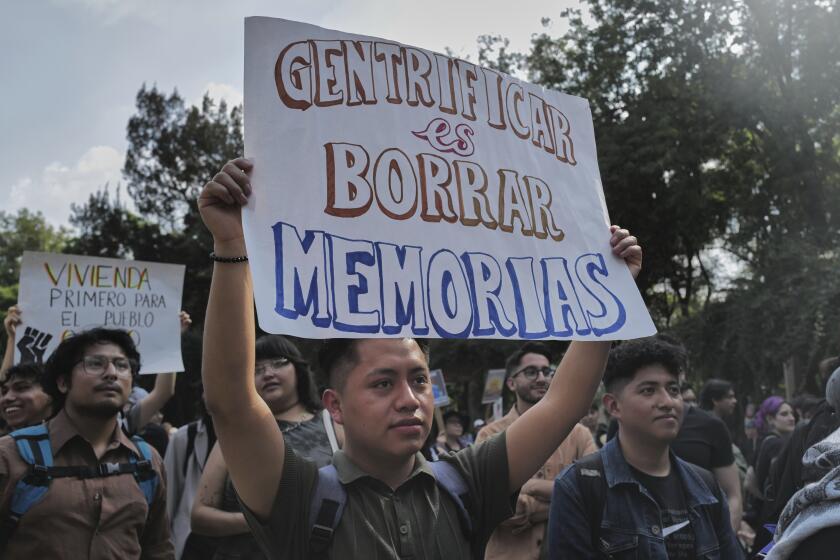Dialogue Winning Against Gang Bullets : Peace: A truce among Latino gangs in the Valley may have drastically reduced the number of young men gunned down.
- Share via
VAN NUYS — They have spent their nights and weekends on darkened Valley streets, talking to warriors about peace.
They have stared down gun barrels and stood between angry combatants.
They have read Scriptures and fasted and prayed.
After nearly a year of struggling to keep the peace, organizers of a truce among Latino gangs in the San Fernando valley say their work has drastically reduced the number of young men gunned down in gang violence. Police report a drop of two thirds in all Valley gang homicides--from 37 to 12 in a one-year period--and the peacemakers say only one of those deaths involved a Latino gang member covered by their truce.
“As weary as you get physically, spiritually, inside of you, it’s exciting,” said William (Blinky) Rodriguez, a Sylmar businessman who helped craft the treaty. “It’s the beginning of hope, of peace.”
Gang members, treaty organizers, local politicians and other supporters will gather at the Church on the Way in Van Nuys Saturday to celebrate what they say is the unprecedented success of the peace treaty.
The “Peace Summit” will include performances by rap artists, speeches by gang members and supporters of the treaty and the reading of a letter from South African President Nelson Mandela by renowned ethologist Jane Goodall, who will attend the event, Rodriguez said. Ethology is the study of animal behavior.
While there have been some incidents of violence, including the killing of a gang member participating in the truce, the number of gang-related homicides in the Valley has declined significantly, police say.
“I’m not surprised, but I don’t take it for granted,” Rodriguez said of the treaty’s apparent success. “Every single day is like a diamond.”
The truce began last Halloween, in part by order of the Mexican Mafia, a prison-based gang.
On that day, several hundred Latino gang members attended a meeting called by Donald Garcia and Rodriguez, both Christian lay ministers. Garcia is a former gang member who served a prison term for murder and Rodriguez’s son was killed four years ago by gang members.
Since then members of the seven-member peace treaty council and gang members have met every weekend at the Pacoima Recreation Center to hammer out resolutions to problems and to nurture a tenuous peace. Rodriguez, Donald Garcia, and others on the council open their meetings with Scriptures and prayers.
Late at night the men are on call, responding to conflicts that could quickly lead to violence. On the streets they play the role of mediators, hearing both sides of a dispute, then helping forge a resolution that does not include bloodshed.
The work is dangerous, they admit, and to do it successfully requires the respect of the gang members they work with, and divine help, they say.
“We realize when we hit those streets we’re facing death,” said Steve Martinez, 28, a member of the council.
*
“We’re out there and we give our lives to the Lord. . . . We’re all Christians, and we give all the Glory to God in the name of Jesus. He’s the only reason we’ve been able to do this for so long.”
According to police, there were 37 gang-related homicides recorded in the Valley for the year ended in September, 1993. For the same period this year, there were 12.
But police note that the decline in gang-related homicides is not limited to the Valley. In all of Los Angeles, there were 276 gang-related homicides by the end of September, 1993. For the year ended last month, there were 182.
The decline in Valley gang-related homicides could be the result of several factors, including better crime analysis information and more officers on the street, as well as the treaty, said Lt. Fred Tuller, coordinator for the Valley of the police anti-gang unit called CRASH--Community Resources Against Street Hoodlums.
“These are all factors,” Tuller said. “We’re talking about something that’s not scientific. I will give Blinky Rodriguez credit. I think he has played a role and we welcome that.”
None of the organizers of the truce is paid for the work, and this year Rodriguez has seen his share of “skeptics, criticism and people with polluted agendas,” he said.
But beyond the numbers, the impact of the truce can be seen in the lives of its participants, Rodriguez said.
Nine months ago Alex Martinez, Steve’s brother, was a gang member. “I started dealing drugs, I was smoking drugs, I was on a real low,” Alex Martinez said.
He became involved, first as a representative of his gang, attending weekend meetings. Later he left the gang and became a member of the council, one of the group who takes to the streets to head off bloodshed.
“I’m still from the ‘hood,” Martinez said. “You never leave that, but I’m not a gang member. I couldn’t do it no more.”
More to Read
Sign up for Essential California
The most important California stories and recommendations in your inbox every morning.
You may occasionally receive promotional content from the Los Angeles Times.












